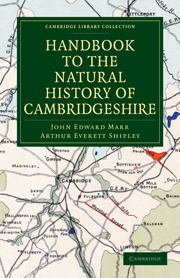Book contents
- Frontmatter
- PREFACE
- Contents
- ADDENDA AND CORRIGENDA
- PHYSIOGRAPHY
- GEOLOGY
- VERTEBRATE PALÆONTOLOGY
- ZOOLOGY
- Mammals
- Birds
- Reptiles and Amphibians
- Fishes
- Mollusca
- Insects: Introduction
- Insects: Orthoptera
- Insects: Neuroptera
- Insects: Hemiptera
- Insects: Coleoptera
- Insects: Lepidoptera
- Insects: Diptera
- Insects: Hymenoptera
- Myriapoda
- Arachnida
- Crustacea
- FLORA
- PREHISTORIC ARCHÆOLOGY
- Appendix to the Article on the Mollusca
- INDEX
- Plate section
Arachnida
Published online by Cambridge University Press: 10 November 2010
- Frontmatter
- PREFACE
- Contents
- ADDENDA AND CORRIGENDA
- PHYSIOGRAPHY
- GEOLOGY
- VERTEBRATE PALÆONTOLOGY
- ZOOLOGY
- Mammals
- Birds
- Reptiles and Amphibians
- Fishes
- Mollusca
- Insects: Introduction
- Insects: Orthoptera
- Insects: Neuroptera
- Insects: Hemiptera
- Insects: Coleoptera
- Insects: Lepidoptera
- Insects: Diptera
- Insects: Hymenoptera
- Myriapoda
- Arachnida
- Crustacea
- FLORA
- PREHISTORIC ARCHÆOLOGY
- Appendix to the Article on the Mollusca
- INDEX
- Plate section
Summary
The four British orders of land Arachnida, (1) Chernitidea or false-scorpions, (2) Araneae or spiders, (3) Phalangidea or harvestmen, and (4) Acari or mites, are all well represented in the neighbourhood of Cambridge. But while the Cambridge list of spiders is a respectable one, comprising more than 180 out of about 500 British species, and a certain number of the comparatively few British species of harvestmen and falsescorpions have been locally recorded, hardly any attempt has been made to grapple with the large and important group of the mites, which probably, in the number of species, and most certainly in the number of individuals, would far out-number all the other local Arachnida put together.
A few words will suffice with regard to the local falsescorpions or harvestmen, but there are points of interest in connection with the spiders which call for a somewhat larger notice.
(1) The Chernitidea or false-scorpions are creatures so small in size, and so retiring in habit, that it is quite possible for an observant person to pass years without ever seeing a specimen, unless he is specially searching for these animals or for other small creatures which affect similar haunts. It is just possible he may have noticed examples clinging to the legs of house-flies, or come across a “book-scorpion” between the leaves of some disused volume.
- Type
- Chapter
- Information
- Handbook to the Natural History of Cambridgeshire , pp. 193 - 203Publisher: Cambridge University PressPrint publication year: 2010First published in: 1904

